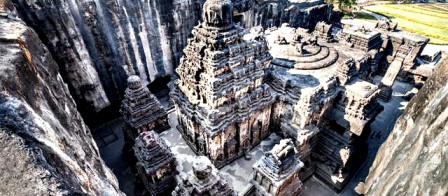Buddhism – History Study Notes & Stuff
Buddhism in Ancient India history
Life of Gautama Buddha:
• The founder of Buddhism was Gautama Buddha, whose childhood real name was Siddhartha.
• Siddhartha was born in the Kshatriya Shakya dynasty of Lumbini (now in the region of Nepal) in 566 BC, hence the Buddha is also known as Shakyamuni.
• He died at Kushinagar (near Gorakhpur in Uttar Pradesh) at the age of 80 in 486 BC.
• Siddharth's mother was 'Mahamaya', who died after his birth. After this, he was reared by Prajapati Gautami, hence he was also known as Gautam.
• His father's name was Suddhodana and he was the only son of his father.
• Siddharth wife name was Yashodhara. They had a son named Rahul. But neither his wife nor his son could tie him to worldly life.
• He left his home at the age of 29 to seek truth and end suffering, and became an ascetic. This event of life of Buddha is known as "Mahabhinishkramana".
• Teachers of Buddha Were - Alara and Udarak.
• After wandering for seven years, at the age of 35, Siddhartha attained enlightenment in Uruvela while meditating on the banks of the Niranjana River under a peepal (banyan) tree. That tree is called Bodhi tree and the place is known as Bodh gaya.
• Buddha attained enlightenment on the full moon of Vaishakh month.
• Buddha delivered his first sermon at Sarnath (Varanasi). This historical event of life of Buddha is known as "Dhammachakra Pravartan".
• As noted above, Buddha died under a Sal tree in Kushinagar (Kushinagar was under Licchavi Kingdom) in 486 BC.
• Various rulers of his time were disciples of Buddha such as Prasenjit, Bimbisara, and Ajatashatru.
• Some famous monks (Bhikshuk) of Buddhist were Sariputra, Anand, Mahakassapa, Anuradha, Upali, and Rahula.
• Vardhamana Mahavira (Jainism) was a contemporary of Gautama Buddha (Buddhism).
• The Event in Life of Buddha are depicted by various symbols in Buddhism:
Event in Life of Buddha - Symbolised by:
Birth of Buddha - Lotus & Bull
The Great Departure (Mahabhinishkramana) - Horse
Enlightenment (Nirvana ) - Bodhi Tree
First Sermon (Dharmachakrapravartana) - Wheel
Death (Parinirvana) - Stupa
Buddhist Philosophy:
• Buddhist philosophy is based at the middle path or Madhyam Marg.
• According to madhyam marga philosophy, both the extremes of the world- indulgence and strict abstinence both are avoided and a middle path is followed between them.
• The main teachings of the Buddha are summarized in Buddhism the four noble truths (Aryasatya):
1. Dukkha - World is full of sorrow
2. samudaya - Desire is the cause of sorrow
3. Nirodha - if desire is conquered all sorrow is won over
4. Ashtangika Marga - Desire can be conquered by following eight fold paths
• Desire can be conquered by following the noble eightfold path:
1. Samyak Drist: Right Understandingbuddhism history study material & notes
2. Samyak Sankalpa: Right Resolve
3. Samyak Vani: Right Speech
4. Samyak Karma: Right Action
5. Samyak Ajiv: Right Living
6. Samyak Vyayam: Right Efforts
7. Samyak Smriti: Right Mindfulness/thought
8. Samyak Samadhi: Right Self-Concentration
• Three base Pillar known as Triratna in Buddhism: Buddha, Dhamma, Sangha.
1. Buddha means having the highest spiritual potential in every human being.
2. Dhamma meaning to the teachings of the Buddha.
3. The Sangha is an organization of monks (Bhikshuk) practicing Buddhism.
Buddhist Works:
• One of the reasons for the spread of Buddhism in the subcontinent was the use of Pali. Pali, unlike Sanskrit, was the language of the common people, which has been confined to the elite Brahmins.
• Buddhism's literary sources are the three "Tripitakas" written in Pali - Sutta Pitaka, Vinay Pitaka and Abhidhamma Pitaka.
• Dhammapada is considered like the Gita of Buddhism. It is basically the canonical texts of Buddhism.
• Ashwaghosh, a Buddhist monk was the writer of Buddhacarita.
• Milinda panho - It is a Buddhist treatise about a dialogue between the Indo-Greek king Menander and the Buddhist monk Nagasena.
• The doctrine of Sunyavada or the Void is propagated by Nagarjuna, a South Indian Buddhist philosophy. He wrote Mulamadhyamakakarika, where he wrote that Sunita is the nature of all things.
Buddhist Councils:
Four councils/Sangeethis of Buddhism organised under different regimes:
1. First Council
• It was organized in 486 BC under the patronage of Ajatashatru (Haryanka dynasty).
• The monk Maha kassapa Upali presided over the first council.
• It was held in the Sattapani caves in Rajagriha soon after Buddha's death.
• A compilation of Vinaya Pitaka and Sutta Pitaka was concluded here.
2. Second Council
• Under the patronage of the Kalashoka (Shishunaga dynasty) in 383 BC.
• It was held in Vaishali one century after the death of Buddha (Parinirvana).
• The second council was presided over by Sarvakamini.
• First division took place in the Union (Sangha). Theravada and the Mahasanghika split here.
3. Third Council
• Under the patronage of King Ashoka in 250 BC.
• It held in Patliputra.
• It was presided over by Moggaliputta Tissa.
• Compilation of Abhidhamma Pitaka was done in it.
4. Fourth Council
• It was organized in 1st century AD under the patronage of Kanishka(Kushan dynasty).
• It was held at Kundalvana of Kashmir.
• With Asvaghosha headed by Vasumitra.
• Hinayana and Mahayana were the two sects of Buddhism which were divided at that time.
If you want us to add any more details to this article, please do let us know in the comments below.









0 Comments